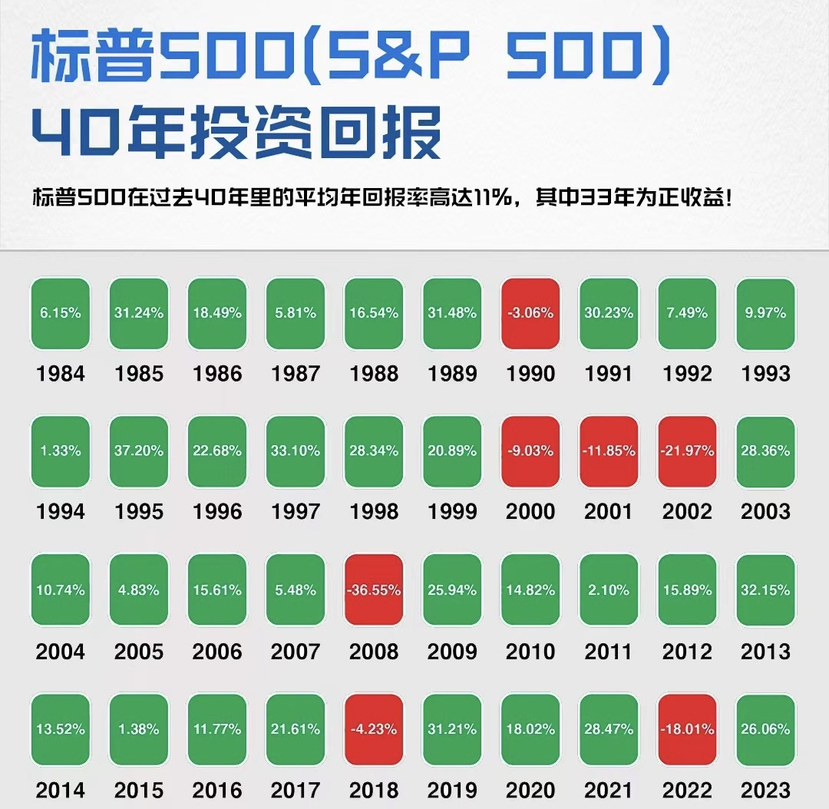As Buffett said, the ideal state of investing is to find 'long slope and thick snow'—a high-quality asset that can accumulate value over the long term. The S&P 500 index is just such an asset, providing considerable returns to investors over the past 40 years and becoming a favorite choice among global investors.

What is the S&P 500 index?
The S&P 500 index, compiled by S&P, represents the overall performance of 500 large companies in the U.S., covering about 80% of the total market capitalization of the U.S. stock market. Therefore, it is not only an important indicator of the health of the U.S. economy and stock market but is also considered a barometer of the global economy.
Why invest in the S&P 500?
1. Diversification of risk: The S&P 500 includes 500 companies from multiple industries, significantly diversifying risk and providing better risk resistance compared to individual stocks.
2. Excellent long-term performance: Historical data shows that despite short-term volatility, the S&P 500 has always maintained a growth trend in the long run.
3. High liquidity: As an index that attracts global investors, S&P 500 investment products have extremely high liquidity, suitable for investors with various risk preferences.
How to invest in the S&P 500?
1. Index funds
Index funds directly replicate the performance of the S&P 500 index, usually with lower management fees, suitable for investors seeking long-term stable returns.
2. ETFs (Exchange-Traded Funds)
ETFs are similar to index funds but can be traded on exchanges like stocks. For example, the SPDR S&P 500 ETF Trust (SPY) is a globally recognized S&P 500 ETF, ideal for investors looking for flexible trading.
3. Direct purchase of constituent stocks
Investors can also purchase the constituent stocks of the S&P 500 themselves to build a similar index-like portfolio. This method is more suitable for experienced investors.
4. Futures and options
For advanced investors, S&P 500 futures and options offer more choices, suitable for attempting higher-yield investments while managing risks.
Factors to consider before investing
1. Fees: The management fees and transaction costs of different products can affect returns; choosing low-cost products helps enhance long-term gains.
2. Market volatility: The volatility of the S&P 500 in the short term requires investors to be mentally prepared and assess their risk tolerance.
3. Economic cycles: The performance of the S&P 500 is influenced by economic cycles; it is advisable to pay attention to economic trends to assist investment decisions.
4. Dividend reinvestment: Many S&P 500 constituent companies offer dividends, and reinvesting dividends can further enhance the compounding effect.
Investment strategy: Timing and holding
• Dollar-cost averaging: Investing a fixed amount monthly or quarterly spreads the risk and reduces timing troubles, making it very suitable for beginners and long-term investors.
• Long-term holding: The S&P 500 is suitable for long-term investment; holding it long-term not only diversifies risks but also enjoys compounding growth.
Conclusion
The S&P 500 index is a robust choice to achieve market-average returns through diversified investments. If you are optimistic about the long-term growth of the U.S. economy, investing in the S&P 500 through index funds or ETFs is a convenient and efficient option. Remember, investing carries risks; reasonably assessing risks, controlling costs, and maintaining a long-term perspective will help you better enjoy the returns brought by the 'long slope and thick snow.'






